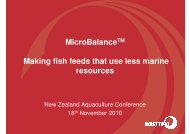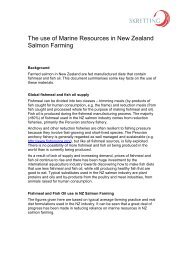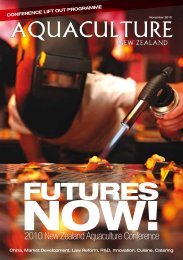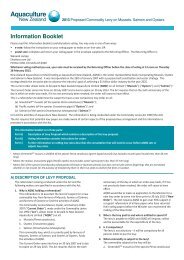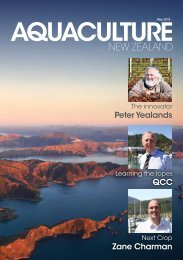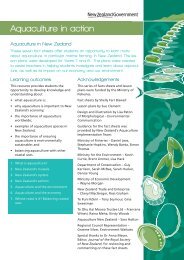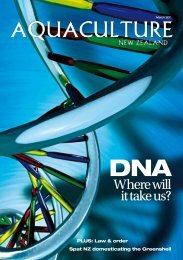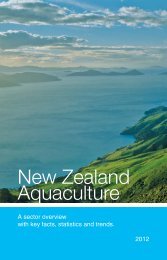Investment - Aquaculture New Zealand
Investment - Aquaculture New Zealand
Investment - Aquaculture New Zealand
- No tags were found...
You also want an ePaper? Increase the reach of your titles
YUMPU automatically turns print PDFs into web optimized ePapers that Google loves.
AQUACULTURE IN NEW ZEALANDA DIVISION OF NEW ZEALAND TRADE AND ENTERPRISE
<strong>New</strong> <strong>Zealand</strong> is one of the world’s finest locations for aquaculture. The <strong>New</strong> <strong>Zealand</strong> government,through <strong>Investment</strong> <strong>New</strong> <strong>Zealand</strong>, is committed to helping investors discover the opportunitiesthat <strong>New</strong> <strong>Zealand</strong> offers aquaculturists and assisting inward investment to this growing sector.INTRODUCTION<strong>New</strong> <strong>Zealand</strong> has thousands of kilometres of pristine, unpolluted coastline situated in the vast South PacificOcean. Its isolated position, far removed from intensive human activity, and many sheltered harbours andbays, make <strong>New</strong> <strong>Zealand</strong> the perfect location for growing a diverse array of shellfish, finfish, seaweed andother aquatic and marine organisms.<strong>New</strong> <strong>Zealand</strong>’s aquaculture sector has advanced at a rapid rate since the late 1980s, having grown at anaverage annual rate of 11.7% by volume over the 20 years to 2005, yet it remains in the early stages of itsdevelopment. The industry is based on natural competitive advantages, supported by in-depth knowledge,excellent research capability and a spirit of innovation.01Global demand for aquaculture products is rapidly rising. With wild fisheries production static due todeclining stocks, there is a continuing shift toward sustainable fisheries practices including aquaculture.The aquaculture industry is of increasing social and economic importance in <strong>New</strong> <strong>Zealand</strong>. <strong>New</strong> <strong>Zealand</strong> hasdeveloped a structured system of aquaculture legislation to manage the competing demands for coastalmarine space and to evaluate the impact of aquaculture on the values placed on the land and coast.There are many successful ventures in the <strong>New</strong> <strong>Zealand</strong> aquaculture industry. A critical success factor is<strong>New</strong> <strong>Zealand</strong>’s pathogen-free environment. The global market demands safe, healthy seafood. <strong>New</strong> <strong>Zealand</strong>delivers this in abundance.<strong>New</strong> <strong>Zealand</strong> is a reputable producer of high-quality, safe food and beverage products.<strong>New</strong> <strong>Zealand</strong> also has a capable and diverse aquaculture research community, actively involved in drivingthe sector through commercial ventures and development partnerships. These organisations welcomeopportunities to work with new investors. Industry-led new species’ development is assisting the sector tomove towards new, high-value species and value-added products that promise to be the future of aquaculturein <strong>New</strong> <strong>Zealand</strong>.The inside of a paua shellA DIVISION OF NEW ZEALAND TRADE AND ENTERPRISEA DIVISION OF NEW ZEALAND TRADE AND ENTERPRISE
Why <strong>New</strong> <strong>Zealand</strong>?The IndustryCONTENTS<strong>New</strong> <strong>Zealand</strong>’s isolated location in the vast SouthPacific Ocean makes it one of the world’s finestenvironments for marine farming. The coastlineis cleansed by strong, cold, nutrient-rich southernocean currents, creating ideal growing conditionsfor a variety of shellfish, finfish, seaweed and othermarine species.<strong>Aquaculture</strong> in <strong>New</strong> <strong>Zealand</strong> has traditionally beendominated by the Greenshell mussel 1 industrywith a smaller-scale industry around Pacific Oysters.The Greenshell mussel continues to lead the wayin terms of volume and export earnings, but thehigh-value King Salmon is now having a significantimpact on the sector.AQUACULTURE IN NEW ZEALAND02Introduction 01Contents 02The <strong>New</strong> <strong>Zealand</strong> <strong>Aquaculture</strong> IndustryWhy <strong>New</strong> <strong>Zealand</strong>? 03The Industry 03<strong>Aquaculture</strong> Species and Technology 06<strong>Aquaculture</strong> Locations 08Industry Structure and Support 09<strong>Aquaculture</strong> Legislation 09<strong>Aquaculture</strong> Success in <strong>New</strong> <strong>Zealand</strong><strong>New</strong> <strong>Zealand</strong> King Salmon 11Clevedon Coast Oysters 12Sealord 13Sea-Right <strong>Investment</strong>s 14Research Capability 15Emerging Opportunities 16Contact Us 18<strong>New</strong> <strong>Zealand</strong> is far removed from intensive humanactivity of the kind responsible for polluting thewaters of many of the world’s biggest aquacultureproducingnations. The absence of inorganic toxinsand the pathogen-free aquatic environment meanthat <strong>New</strong> <strong>Zealand</strong> is one of the few countries in theworld where shellfish do not require depurationprior to processing. Pacific Oysters from <strong>New</strong><strong>Zealand</strong> are certified by the Japanese Ministry ofHealth and Welfare for sale in their raw form.The <strong>New</strong> <strong>Zealand</strong> government enacts legislationdesigned to prevent harmful activities (aquacultureor otherwise) degrading the marine environment.The industry maintains robust water-testingprocedures. As a consequence, marine farmers areable to meet the growing global demand for safe,healthy seafood produced through sustainableaquaculture activities with a high level ofenvironmental performance.Many of the production techniques developed in<strong>New</strong> <strong>Zealand</strong> are world-leading and demonstratea spirit of innovation that has helped to shape theindustry. There is an active aquaculture researchand development community in <strong>New</strong> <strong>Zealand</strong> thatis able to reduce investment risk substantially.The total value of aquaculture production in <strong>New</strong><strong>Zealand</strong> was approximately NZ$289 million for the2004 year 2 . One third of output was consumeddomestically; the remainder was exported.The aquaculture industry in <strong>New</strong> <strong>Zealand</strong> isforecasting a continuation of recent rapid growth. The<strong>New</strong> <strong>Zealand</strong> <strong>Aquaculture</strong> Council 2005 annual reportforecasts total aquaculture sales of NZ$1,330 millionby 2024; of this total NZ$1,038 million is assumed torepresent export sales. This represents a cumulativeaverage growth rate of over 8% per annum.The graphs on the following page show the strongproduction and export earnings growth in theGreenshell mussel and King Salmon industries.The reduction in export earnings observed in 2003and 2004 is due to a high <strong>New</strong> <strong>Zealand</strong> dollar anda decrease in the international commodity pricefor mussels and salmon. In general, <strong>New</strong> <strong>Zealand</strong>aquaculturists are looking to position themselvesat the high-value end of their respective markets,thereby avoiding commodity price fluctuations. Thereduction in King Salmon volumes from 2001-02levels is due to a strategic repositioning of one of<strong>New</strong> <strong>Zealand</strong>’s larger King Salmon farmers.03Established industry associations by species andregion highlight the degree of co-operation in theindustry. Formal skills-based training programmesdemonstrate the commitment from the industryto ensure the long-term success of the sector byproviding the means to produce a highly skilled poolof workers.Photo courtesy of The Cawthron Institute<strong>New</strong> <strong>Zealand</strong> is a country that has developed astrong aquaculture industry based on the qualityof its environment and the innovation andperseverance of its investors.Packaging shellfish1 The Greenshell mussel is a native variety of green mussel found only in<strong>New</strong> <strong>Zealand</strong> and is prized for its texture, versatility and delicate fl avour.2 Figures obtained from the <strong>New</strong> <strong>Zealand</strong> Marine Farming Association.Paua spatA DIVISION OF NEW ZEALAND TRADE AND ENTERPRISEA DIVISION OF NEW ZEALAND TRADE AND ENTERPRISE
3The Industry (cont.)<strong>New</strong> <strong>Zealand</strong>’s proportion of global aquaculture production has remainedbroadly static over the past ten years at between 0.15% and 0.25%, despite worldaquaculture increasing significantly due to large volumes of low-value productsfrom nations such as China and Chile. Although <strong>New</strong> <strong>Zealand</strong>’s share of worldaquaculture is small, it is representative of a greater focus on high-value productsearning greater returns per hectare of marine farm.The following table presents the number of individual farms by major species in<strong>New</strong> <strong>Zealand</strong> as at 2004 5 , along with industry estimates of total sales (domesticand export) for the same period 6 .speciesnumber offarmstotalhectares ofmarine spacetotalestimated salesNZ$millionGreenshell mussels 645 4,747 1813Pacific Oysters 230 750 26King Salmon 23 60 81AQUACULTURE IN NEW ZEALAND<strong>New</strong> <strong>Zealand</strong> has established significant export markets for its aquacultureproducts in Japan, the United States, the European Union and Australia. Thetables below show the top five export destinations for <strong>New</strong> <strong>Zealand</strong>-producedKing Salmon, Pacific Oysters and Greenshell mussels for 2005.export destination/speciesexport volume(‘000 tonnes)export value(NZ$000 FOB)04Greenshell musselsUnited States 13,263 59,327Spain 3,208 15,964Australia 2,892 15,320South Korea 2,823 14,14205Global growth in seafood production has averaged 2.7% per annum since 1993. With static or declining wildfisheries production, it is aquaculture that has driven this growth.4United Kingdom 1,436 6,885King SalmonJapan 2,000 15,0473Statistics from <strong>New</strong> <strong>Zealand</strong> Marine Farming Association4Statistics from United Nations Food and Agriculture OrganisationAustralia 593 6,186United States 435 3,195Taiwan 74 495Vietnam 53 410Pacific OystersAustralia 982 7,101Japan 398 3,288United States 243 1,695French Polynesia 216 1,299<strong>New</strong> Caledonia 109 6875 Figures from the <strong>New</strong> <strong>Zealand</strong> <strong>Aquaculture</strong> Council.6 Figures from the <strong>New</strong> <strong>Zealand</strong> Marine Farming Association.Photo courtesy of The Cawthron InstituteOyster farmA DIVISION OF NEW ZEALAND TRADE AND ENTERPRISEA DIVISION OF NEW ZEALAND TRADE AND ENTERPRISE
<strong>Aquaculture</strong> Speciesand TechnologyOne way to consider the sphere of opportunitiesin aquaculture in <strong>New</strong> <strong>Zealand</strong> is to examinethe marine farming technologies employed andthe species that can be produced using thesetechniques. The left-hand side of the followingfigure describes the range of techniques employed,the middle of the diagram indicates the location(either saltwater or freshwater) and the right-handside features the species that can be farmed usingthese methods in particular locations.<strong>New</strong> <strong>Zealand</strong>’s aquaculture industry ispredominantly involved in long-line farming forGreenshell mussels, intertidal farming for PacificOysters and cage farming for King Salmon. Thetechnology tree approach is an ideal way to considerthe impacts that a particular method of aquaculturewill have for a given array of species.The technology approach gives an effects-baseddecision-making process (rather than a speciesbasedapproach), which fits well with <strong>New</strong> <strong>Zealand</strong>’saquaculture legislation.<strong>Aquaculture</strong> Species and Technology (cont.)Mussel farmThe following diagram represents the current arrayof opportunities for the farming of species thatexists within the <strong>New</strong> <strong>Zealand</strong> aquaculture sector.The inner core of the diagram represents specieswith well established technology and successfulventures involved in producing that species. Theinner circle represents species that are the focusof significant research and some limitedcommercial ventures. The outer circle representsspecies that have yet to be explored in <strong>New</strong><strong>Zealand</strong> to any great extent but which maypresent opportunities in the future.There is a significant research community in <strong>New</strong><strong>Zealand</strong> that is investing considerable resourcesinto new species’ development. Kingfish and SeaSponges are two species that have been the focusof recent efforts.07A DIVISION OF NEW ZEALAND TRADE AND ENTERPRISEA DIVISION OF NEW ZEALAND TRADE AND ENTERPRISE
<strong>Aquaculture</strong> LocationsThe location of aquaculture in <strong>New</strong> <strong>Zealand</strong> isdictated by the availability of sheltered regionswith good tidal flows and the appropriate seawatertemperature range for the given species. The mapbelow indicates the areas in <strong>New</strong> <strong>Zealand</strong> whereaquaculture activities are most prominent 7 .Seawater temperature determines the appropriatespecies to farm and farm locations. <strong>New</strong> <strong>Zealand</strong>has three broad seawater temperature zones,a warm zone north of a horizontal line throughHamilton, a temperate zone from south of Hamiltonthrough to just south of Wellington and a cool zonesouth of Wellington.<strong>Aquaculture</strong> legislation is designedto foster the long-term developmentof the industry by protecting theenvironmental advantages that<strong>New</strong> <strong>Zealand</strong> has over its competitors.<strong>New</strong> <strong>Zealand</strong> Greenshell musselsAQUACULTURE IN NEW ZEALAND087 This map is reproduced courtesy of the <strong>New</strong> <strong>Zealand</strong> MarineFarming AssociationIndustry Structureand SupportThere is a high degree of co-operation andcollaboration through various industry bodies andassociations. The principal, overarching organisationfor aquaculture is the <strong>New</strong> <strong>Zealand</strong> <strong>Aquaculture</strong>Council Inc (“NZAqC”), which is made up ofrepresentatives from the three major species groupsplus representation from abalone (“paua”) producers.Non-voting observer status is granted to otherorganisations that have an interest in aquaculture,at either a national or a local level. The NZAqCrepresents on an “as-needed” basis the collectiveinterests of the <strong>New</strong> <strong>Zealand</strong> aquaculture sector.Owing to the rapid growth of the <strong>New</strong> <strong>Zealand</strong>aquaculture industry over the past decade, thereis an ever-increasing need for skilled people at alllevels of the industry. The Seafood Industry TrainingOrganisation (“SITO”) was established to addressthis demand. SITO works closely with the industryto develop qualifications and training standards,an example being the National Certificate in<strong>Aquaculture</strong>, which directly benefits the industryby standardising operational practices and benefitsindividuals by providing formal recognition of theirskills and experience.The industry and government are committed toproviding funding and the structure to develop apool of trained aquaculture workers.<strong>Aquaculture</strong> Legislation<strong>New</strong> <strong>Zealand</strong> has developed a structured system ofaquaculture legislation to manage the competingdemands for coastal space required for aquacultureand to evaluate the impact of aquaculture on thevaried values placed on the land.The challenges of managing aquaculturedevelopment are not unique to <strong>New</strong> <strong>Zealand</strong>.<strong>Aquaculture</strong> legislation is designed to fosterthe long-term development of the industry byprotecting the environmental advantages that <strong>New</strong><strong>Zealand</strong> has over its competitors.<strong>Aquaculture</strong> legislation in <strong>New</strong> <strong>Zealand</strong> underwenta series of major reviews in the late 1990s and in2000, culminating in the 2004 aquaculture lawreforms. <strong>New</strong> <strong>Zealand</strong>’s regional councils now takethe lead role in terms of coastal management andgranting consents for new marine farms.<strong>New</strong> marine farms are to be located in specialcoastal areas known as <strong>Aquaculture</strong> ManagementAreas (“AMAs”). AMAs are designed to be a coastalmanagement tool to assist in considering thecumulative environmental, commercial and socialimpacts of aquaculture. AMAs are to be specifiedin a particular regional or unitary council’s regionalcoastal plan.The aquaculture law reform aims to:“… enable the sustainable growth of aquacultureand ensure the cumulative environmental effectsare properly managed while not undermining thefisheries regime or Treaty of Waitangi 8 settlements ”9 .The Maori people of <strong>New</strong> <strong>Zealand</strong>, represented byindividual tribes (“iwi”), play an important role inthe history and future of the fisheries industryin <strong>New</strong> <strong>Zealand</strong>. Related to the Crown’s Treaty ofWaitangi obligations, iwi are entitled to 20% ofmarine farm space consented since 1992 and20% of all future consented marine farm space.The allocation of marine farming space to iwipresents opportunities for investors to partnerwith iwi in developing their entitlements.8 Treaty of Waitangi settlements are Crown apologies,commercial redresses and/or cultural redresses relating tohistorical breaches of <strong>New</strong> <strong>Zealand</strong>’s founding documentsigned in 1840 by the indigenous people of <strong>New</strong> <strong>Zealand</strong>and the British Crown.9 Text from the <strong>Aquaculture</strong> Reform Bill 2004,explanatory note.09A DIVISION OF NEW ZEALAND TRADE AND ENTERPRISEA DIVISION OF NEW ZEALAND TRADE AND ENTERPRISE
<strong>Aquaculture</strong> Legislation (cont.)This table details the potential allocation of newly consented marine farm space under the three methodsof applying for an AMA.ama methodiwi allocation implicationsAQUACULTURE SUCCESS IN NEW ZEALANDThere is no better evidence of the quality of <strong>New</strong> <strong>Zealand</strong> as an aquaculture location than that foundin the companies and individuals at the forefront of this innovative industry. The four companiesprofiled in this document are representative of the breadth of opportunities in the industry andprovide an indication of the unique factors that have contributed to their organisations’ successes onthe domestic and global stages.NEW ZEALANDCouncil-initiated plan changeInvited private plan changeNormal private plan change20% of space allocated to iwiAn additional 20% may be allocated to iwi to assist in satisfying theCrown’s obligations regarding existing aquaculture space if requiredUp to 40% in total may be allocated to iwi20% of space allocated to iwi20% of space allocated to iwiAn additional 20% may be allocated to iwi to assist in satisfying theCrown’s obligations regarding existing aquaculture spaceUp to 40% in total may be allocated to iwi<strong>New</strong> <strong>Zealand</strong> KingSalmonThe <strong>New</strong> <strong>Zealand</strong> King Salmon CompanyLimited (“NZKS”) is a vertically integratedsalmon farming, processing and marketingorganisation. King Salmon at NZKS areproduced with an intensive family broodstockprogramme using land-based, freshwaterhatchery technology with subsequent rearingin sea cages.Salmon are raised from eggs in hatcheries andare transferred to outside raceways when theyare fry. After a period of eight to 13 months(from eggs), salmon smolt are transferredto sea cages where they are reared on acontrolled food source to a market size of3.5-4.0 kilograms. The entire lifecycle isbetween 19 and 31 months, designed to fityear-round market and end-productrequirements. NZKS produces more than5,000 tonnes of King Salmon annually,generating revenue of NZ$64 million of whichNZ$31 million is from salmon product exportsto Japan, Australia, the US, Pacific Islands andother Asian nations.In marketing its 159 individual products, NZKSactively promotes the natural processesby which its salmon are grown and thequality of the environment in which they arecultivated. The temperature and purity ofthe water are vital to the quality of the endproduct. The salmon produced by NZKS donot require antibiotics, vaccines or chemicaltreatments and are not subjected to any formof growth hormone or bovine or geneticallymodified product. All of these factors featureprominently in the marketing of NZKS products.“Faced with higher costs in a verycompetitive market, the quality and purity of<strong>New</strong> <strong>Zealand</strong>’s marine environment is criticalto producing the superior products that arethe foundation of our domestic and exportvalue-added business focus.”– Paul Steere, Chief Executive,<strong>New</strong> <strong>Zealand</strong> King SalmonNZKS seeks to add value to its products bypromoting demonstrated quality standards,providing a consistent year-round supply,actively promoting the uniqueness of theproducts and the environment in which theyare cultivated and demonstrating the completetraceability of its products.NZKS has managed to internalise almost all ofthe processes involved in getting its productsto market. In doing so, it has utilised <strong>New</strong><strong>Zealand</strong>’s natural competitive advantages, interms of its pathogen-free environment andideal growing conditions, to create a brandwith a story that appeals to a broad range ofdomestic and foreign consumers.11Salmon swimming upstreamPhoto courtesy of The Cawthron InstituteBaby PauaA DIVISION OF NEW ZEALAND TRADE AND ENTERPRISE
Photo courtesy of The Cawthron InstituteAQUACULTURE IN NEW ZEALAND12Clevedon Coast OystersClevedon Coast Oysters (“CCO”) is a premiumbrand of Pacific Oysters produced in theHauraki Gulf, east of Auckland. CCO oysters areproduced using a combination of intertidal spatcatching, intertidal on-growing on racks andlong-line culture. CCO produces approximately400,000 dozen oysters each year. From thetime of spat placement, Pacific Oysters in <strong>New</strong><strong>Zealand</strong> take between 12 and 18 months toreach harvest size.CCO oysters are sold domestically and arealso exported under the JEMCO brandand the CCO brand. JEMCO is a successfuljoint venture between four pacific oystergrowers and a marketing company, formedto co-ordinate efforts by <strong>New</strong> <strong>Zealand</strong> oysterproducers to develop long-term internationalmarkets. The marketing efforts of JEMCO arelargely credited with accessing the lucrativeJapanese market for raw oysters – <strong>New</strong><strong>Zealand</strong>-produced oysters are accredited by theJapanese Ministry of Health and Welfare forraw consumption in Japan.“A consistently high quality product is vital tothe success of our business. The abundance ofnatural spat fall and our pathogen-free marineenvironment are key to producing such highquality oysters.”- Callum McCallum, Managing Director,Clevedon Coast OystersJEMCO’s success lies in the comprehensivemicrobiological and biotoxin monitoringprogrammes adopted by the farmers. Theirphytoplankton monitoring process andadditional quality control measures areworld leading.<strong>New</strong> <strong>Zealand</strong>’s high-quality water providesCCO with a significant competitive advantagein producing premium-grade Pacific Oysters.<strong>New</strong> <strong>Zealand</strong>’s waters are highly productivedue to high algae populations and the presenceof natural spat fall. This offers CCO a cost andquality advantage over many internationalcompetitors who rely on hatchery technologyto provide spat.<strong>New</strong> <strong>Zealand</strong>’s water is considered very safefor growing oysters, with a complete absenceof inorganic toxins and pathogens andrigorous monitoring programmes to detectthe presence of any organic pathogens.<strong>New</strong> <strong>Zealand</strong> oysters are not requiredto undergo depuration or post-harvestdisinfection processes.CCO’s success in export markets is builton the back of its brand, which leveragesoff its high-quality growing conditionsand production processes. CCO becamethe first oyster production companyin the world to achieve organiccertification in 2005.Pacific OystersSealordSealord Limited (“Sealord”) is a global seafoodventure with its <strong>New</strong> <strong>Zealand</strong> headquartersin Nelson. Approximately NZ$40 million ofthe Sealord Groups NZ$600 million annualturnover is attributable to Greenshell musselfarming and processing activities. Sealordprocesses 20,000 tonnes of Greenshellmussels annually, making it the largestprocessor in <strong>New</strong> <strong>Zealand</strong>.In terms of accessing international markets,Sealord has been able to utilise its establisheddistribution network for capture fisheries tomarket its aquaculture products. This not onlyeases the transition into foreign markets butpermits the exercise of a degree of volumedrivensupplier power when negotiatingwith distributors and customers. Sealord hasinvested heavily in market infrastructure,including a recent new investment targetedat servicing the rapidly developing markets inEastern Europe.“<strong>New</strong> <strong>Zealand</strong> Greenshell mussels areuniquely attractive, great tasting, andsafe eating mussels from pristine waters.Positively boutique in a mass of one milliontonnes of blue and black mussels.”– Jon Safey, Marketing Manager,Sealord GroupSealord believes that the <strong>New</strong> <strong>Zealand</strong>Greenshell mussel industry leads the world interms of on-farm productivity. The continuousrope growth technology and strength of thespecies mean that there is very little wastagein harvesting (i.e. product ending up on thesea floor). The industry’s robust water qualityprogrammes, particularly the phytoplanktontesting processes, are further significantcompetitive advantages.Sealord actively engages with <strong>New</strong> <strong>Zealand</strong>’saquaculture research and developmentcommunity. It has particularly benefited fromits research partners as they have demonstrateda willingness to put their research on the line ina commercial sense.Sealord markets an organic Greenshellmussel, having achieved the standards andcodes of practice stipulated by BioGro <strong>New</strong><strong>Zealand</strong>. Sealord sees demand for seafoodproducts sourced from sustainable fisheriescontinuing to increase, providing furtheropportunities for the aquaculture sector.This trend is demonstrated in the decisionby US retailer, Wal-Mart, to source itsseafood products from sustainablefisheries resources exclusively.<strong>New</strong> <strong>Zealand</strong> Greenshell mussel13
AQUACULTURE IN NEW ZEALAND14Sea-Right <strong>Investment</strong>sSea-Right <strong>Investment</strong>s Limited (“Sea-Right”)is a small, highly innovative company thatproduces and markets a variety of aquaculturerelatedproducts. Its principal product is EyrisBlue Pearls. These pearls are cultivated insidepaua (abalone) and represent a world first forfarmed production on a commercial scale. Pauapearls are prized for their beauty and vast arrayof colours.The paua (Haliotis Iris), a species of abaloneunique to <strong>New</strong> <strong>Zealand</strong>, is carefully gatheredby free diving and transported to ocean-basedfarms. The locations selected for the oceanbasedfarms offer optimal conditions for bluepearl culture sheltered harbours with pristinewaters that are rich in nutrients with easyaccess to seaweed. The abalone feed on agourmet diet of different seaweeds consumingup to 50% of their own body weight per week.The method for cultivating a blue pearl involvesinserting a specially designed plastic seedbetween the flesh and shell of the paua in aprocess termed nucleation. After a minimumperiod of 18 months but up to three years theharvest takes place. Approximately 20% ofthe pearls are of marketable quality andonly 2% produce what is termed a gem qualitypearl with a perfect skin, mirror finish andflawless colour.Blue pearl sales have increased significantly overthe past few years, with interest from aroundthe world. In 2006, Eyris Blue Pearl collectionsare being launched in Italy and in the US atthe JCK Las Vegas Jewellery Fair. Much of thebranding platform for this gem is focused onthe uniqueness of <strong>New</strong> <strong>Zealand</strong> and its naturaladvantages – the pristine waters and intensecolours that are reflected in the blue pearls.The integrity of the blue pearls is critical tothe success of the gem. Sea-Right can offera complete guarantee of authenticity as thepearls are tracked throughout the culturingand grading process. Each pearl is sold with aguarantee, giving consumers assurance that thepearls are of natural colour and lustre and thatthey are cultured in harmony with nature. TheSea-Right team has strived for many years todevelop and optimise culturing methodologies.The products produced by Sea-Right are qualityexamples of the high-value species and productsthat can be produced in <strong>New</strong> <strong>Zealand</strong>. Innovationand the use of good science in productionprocesses, combined with a marketing angle thatutilises <strong>New</strong> <strong>Zealand</strong>’s competitive advantagesin aquaculture production, have been critical toSea-Rights success.“Sea-Right <strong>Investment</strong>s Ltd is in the businessof enhanced aquaculture. We believe Securityof Harvest Ensures Replenishment and to backthis up we are actively involved with largescale abalone reseeding and kelp research.Isolation, once seen as a barrier to overseasmarkets, is now a competitive advantage. Thebeauty and rarity of Blue Pearls and the healthand taste of Kelp Pepper reflect <strong>New</strong> <strong>Zealand</strong>’simage as a far away paradise.”– Roger Beattie, Managing Director,Sea-Right <strong>Investment</strong>s LtdThe Eyris Blue Pearl<strong>New</strong> <strong>Zealand</strong> Greenshell musselsRESEARCH CAPABILITY<strong>New</strong> <strong>Zealand</strong> has a highly capable and diverseaquaculture research community that is activelyinvolved in driving the sector through commercialventures and development partnerships. Thedepth of <strong>New</strong> <strong>Zealand</strong>’s research capability isbest highlighted by examining the activities ofthe country’s leading aquaculture research anddevelopment institutes.The National Institute of Water and AtmosphericResearch Limited ( NIWA ) has the largest team ofcoastal marine scientists in <strong>New</strong> <strong>Zealand</strong>. NIWAScience provides the underlying research capability,through its National Centre for Fisheries and<strong>Aquaculture</strong>, to assist clients with the technicalaspects of aquaculture in <strong>New</strong> <strong>Zealand</strong> and topromote sustainable resource management.NIWA Natural Solutions is the commercialisationvehicle of NIWA. Its principal role is to transform theknowledge base and intellectual property generatedby NIWA Science into product-based commercialopportunities. This is achieved by undertakingcommercial feasibility studies, identifying marketopportunities and partnering or facilitatingcommercial development activities.A trusted technology partner is a critical successfactor to aquaculture in <strong>New</strong> <strong>Zealand</strong> due to theunique species and marine environment in thiscountry. NIWA’s depth of experience in aquacultureCrop and Food Research hasspecific expertise in processing andpackaging aquaculture products andin identifying the unique propertiesof raw materials from the marineenvironment. Its goal in this area is tomaximise returns from <strong>New</strong> <strong>Zealand</strong>’ssustainable fisheries resource.has evolved with the development of the industry.It is ideally placed to serve most of the aquacultureindustry’s technical needs. NIWA offers a worldclassteam of research scientists and facilitiesthat is able to reduce the risk of an investment inaquaculture in <strong>New</strong> <strong>Zealand</strong>.The Cawthron Institute provides world-leadingresearch expertise in the fields of selective shellfishbreeding, cryopreservation, shellfish health andbroodstock conditioning. Cawthron engages incommercial-scale spat production and providesassistance to industry participants in relation tohatchery technology and engineering, nursery andmarine farm technology. The aim of its shellfishselective breeding programme is to provide marinefarmers with the same benefits that selectivebreeding brings to agriculturists lower productioncosts, higher yields and improved product returns.Crop and Food Research has specific expertise inprocessing and packaging aquaculture productsand in identifying the unique properties of rawmaterials from the marine environment. Its goalin this area is to maximise returns from <strong>New</strong><strong>Zealand</strong>’s sustainable fisheries resource. Cropand Food’s blue skies research programmesand specific partnerships with industryrepresent an important contribution to <strong>New</strong><strong>Zealand</strong>’s aquaculture knowledge base.15A DIVISION OF NEW ZEALAND TRADE AND ENTERPRISE
EMERGING OPPORTUNITIESOpportunities are abundant in the <strong>New</strong> <strong>Zealand</strong>aquaculture industry. One such opportunity relatesto potential development partnerships with iwi.The aquaculture law reforms require that iwi areentitled to allocations of space within new AMAs.Regional councils are required to provide for 20% ofthe space of marine farms established between 1992and 2004 in any new AMAs created since 1 January2004. Councils are also required to provide to iwi20% of any new AMAs created since 1 January 2004.The provision of marine farming space to iwi willopen investment avenues for both iwi and otherinvestors. It is likely that iwi developers will seekpartnerships for the development of marine farmspace and the working capital required to operatethese ventures.other research entities and industry partners ondeveloping farming methods for a sea sponge,Mycale, which has pharmacological components.In its research activities NIWA seeks to establishsustainable aquaculture systems. Investors in the<strong>New</strong> <strong>Zealand</strong> aquaculture industry are well placedto leverage off this to gain a competitive advantagefrom the superior environmental performance ofits production techniques.From this brief description of some of NIWA’sextensive aquaculture research activities, it is clearthat its vision of the future of aquaculture in <strong>New</strong><strong>Zealand</strong> involves extensive investment in highvalueproducts. Examples include finfish such asKingfish, sponges with pharmacological properties,food ingredients with bioactive properties andadding value to existing aquaculture species.AQUACULTURE IN NEW ZEALAND16speciesGreenshell musselsPacific OystersKing Salmonrevenue per annumper hectareNZ$38,000NZ$35,000NZ$1,350,000An example of NIWA’s commitment to developingnew aquaculture species is the Kingfish hatcherylocated at the Bream Bay aquaculture researchfacility. Through continual improvements inhusbandry and research into nutrition andreproductive biology, NIWA scientists have beenable to produce large numbers of high-qualityjuvenile Kingfish.The farming of Kingfish is viewed as a promisingopportunity as:10As a demonstration of how high-value productsmay provide significant avenues for growth in theaquaculture industry, the table presents industryestimates of revenue per annum per hectare bymajor developed species:<strong>New</strong> <strong>Zealand</strong> is well served for aquacultureresearch and development expertise. Along withNIWA, at least two other research institutes andseveral universities are able to provide specificaquaculture-related services.Fish feed technology is not well advanced in <strong>New</strong><strong>Zealand</strong>. There are no specialised extruded feedmills operating at present. This aspect of theaquaculture industry has the potential to drive thefinfish farming industry in the same way that NIWAintends to propel the industry forward with itsmarine hatchery initiatives.the wild catch of the species is seasonal andunpredictable;the species is relatively fast growing, reachingmarketable size in 12-15 months;it has a flesh quality that lends itself to avariety of product types; andthe value of the fish on the internationalmarket is broadly similar to that ofKing Salmon.Kingfish is the first of a range of high-value speciesthat NIWA intends to introduce to the <strong>New</strong> <strong>Zealand</strong>aquaculture industry. In addition, NIWA is workingwith industry partners on developing new seaweedspecies for aquaculture. NIWA is also involved withAt present the high-quality fish food requiredfor the finfish farming industry is imported fromAustralia, Chile or Canada. The lack of millingtechnology and expertise associated with theextruded fish food industry presents significantinvestment opportunities.Partnerships with existing <strong>New</strong> <strong>Zealand</strong>aquaculture industry participants offer afurther means of entry to the sector. As <strong>New</strong><strong>Zealand</strong> marine farmers seek to move further awayfrom commodity-based markets to value-addedproducts, opportunities emerge for food processorsand marketers to engage with farmers to produceeven higher-value products.10 Figures sourced from the <strong>New</strong> <strong>Zealand</strong> <strong>Aquaculture</strong>Council and the <strong>New</strong> <strong>Zealand</strong> Marine Farming Association.A DIVISION OF NEW ZEALAND TRADE AND ENTERPRISE
CONTACT USAs a government agency, <strong>Investment</strong><strong>New</strong> <strong>Zealand</strong> (a division of <strong>New</strong> <strong>Zealand</strong>Trade and Enterprise) helps to promoteand facilitate foreign direct investmentinto <strong>New</strong> <strong>Zealand</strong>. We actively assistinternational investors to:establish green field operationsin <strong>New</strong> <strong>Zealand</strong>;relocate their businesses to<strong>New</strong> <strong>Zealand</strong>; andinvest in and work with <strong>New</strong> <strong>Zealand</strong>companies in global ventures.Our team of 50 professionals, based onshoreand around the world, promotes <strong>New</strong> <strong>Zealand</strong>business opportunities in global markets.We have considerable expertise and offshorenetworks. Together, these generate valuablemarket intelligence and research assistance thatcan greatly reduce costs and set-up time for theinvestor. We work to make your start-up in <strong>New</strong><strong>Zealand</strong> fast and efficient.<strong>Investment</strong> <strong>New</strong> <strong>Zealand</strong> also provides a singlepoint of government contact for foreign investors.Experienced investment managers connect youseamlessly with a network of local economicdevelopment agencies. These local agencies offeranother level of assistance and contact with reputableprivate sector advisers. Any information provided by youin relation to business proposals and plans for investmentin <strong>New</strong> <strong>Zealand</strong> will be treated in strictest confidence.For further assistance please contact our Food andBeverage team on:phone: +64 9 915 9205 or +64 9 366 4768email:FB@investmentnz.govt.nz© Copyright <strong>New</strong> <strong>Zealand</strong> Trade and Enterprise 2006No Part of this publication may be distributed or copied for any commercialpurpose nor incorporated in any work or publication [whether in hard copy,electronic or any other form] without the prior written consent of NZTE.Publication Date: June 2006DISCLAIMER: The information in this report is general and not by way offorecast. It was prepared by <strong>New</strong> <strong>Zealand</strong> Trade and Enterprise (NZTE) frompublicly available sources in 2006. NZTE accepts no liability for the informationcontained within this report not for any reliance placed on it.website: www.investmentnz.govt.nzA DIVISION OF NEW ZEALAND TRADE AND ENTERPRISEISBN: 0478294107



